After reading several of
those lists detailing various manly firearms, I decided to make my own. I agree
with just about everything chosen for the previous lists, but I felt that the
authors missed out on a few good ones. Keep in mind that I tried not to mention
any firearms that were already mentioned in previous lists, so don’t get
offended when you don’t see the AR-15 listed here. It got its time in the
spotlight. Here are some that deserve the same treatment. Let’s kick off the
list with:
Honorable Mention) Remington 700
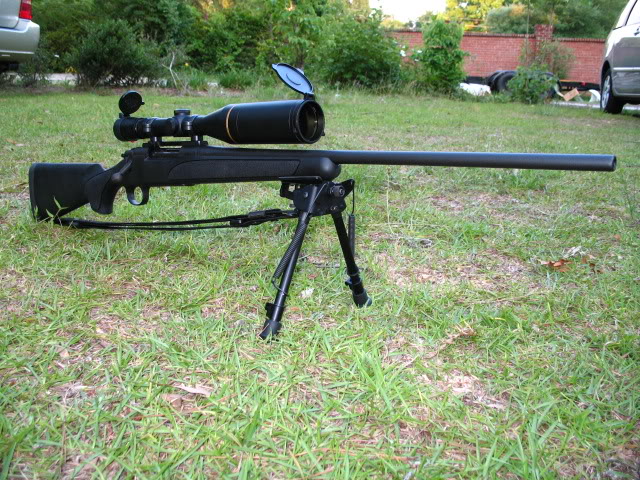
This rifle makes it to the
list out of sheer versatility.
Made for the public, the police, and the military alike, this rifle simply
oozes multi-purpose. Chuck Hawkes (a noted firearms author) remarks, “today it
is available in a bewildering array of models.” Cartridges supported by this
rifle include but are in no way limited to: .17 Rem, .223 Rem, 7mm Rem, .30-06,
.308 Win, and .375
H&H. Wikipedia
lists 20 more cartridges.
10) Brown Bess musket

“In the days of
lace-ruffles, perukes, and brocade
Brown Bess was a partner
whom none could despise -
An out-spoken,
flinty-lipped, brazen-faced jade,
With a habit of looking men
straight in the eyes -
At Blenheim and Ramillies,
fops would confess
They were pierced to the
heart by the charms of Brown Bess.”
--Rudyard Kipling
The original ugly stick, Brown
Bess is a .75 caliber flintlock musket that saw service in the British Empire from 1722 till 1838 (and still later, when
some were converted to percussion cap action). Outside the Empire, they were
used in combat as late as the Battle of Shiloh. No one’s 100% sure where the
Brown Bess got its nickname, but we do know that the British military never officially
used it. It was referred to as a ‘firelock’ or ‘The King’s Arm.’ Weighing in at
10 pounds and just under 5 feet long (the bayonet
pushing it to over 6 feet), this musket required a manly effort just to schlep
around all day. Although it was fairly inaccurate (if you could hit a man-sized
target at 30 yards, you were doing fine) and only worked 80% of the time (still
better than a matchlock, though!), when the .75 caliber lead ball hit
something, that something was toast. It’ll blow
a hole through a two-by-four that you can stick your thumb through. A good
soldier could load this smoke pole
and put a round downrange in less than 20 seconds. Not bad considering that the
accurate rifles of the time took over a minute to load and fire. Just don’t
over-prime the pan or you’ll end up missing an eyebrow, Mythbusters-style.
9) Thompson Submachine Gun
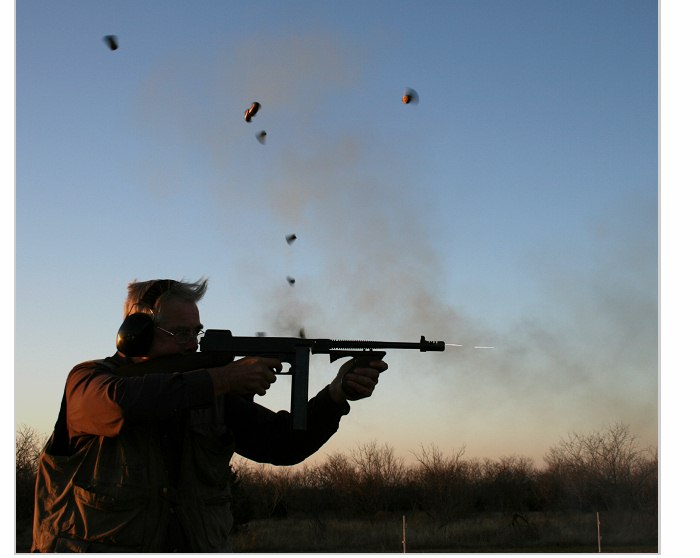
One of the most iconic and
easily recognizable
firearms in the world, this weapon managed to collect some manly nicknames:
Tommy Gun, the Trench Broom, the Trench Sweeper, the Chicago Piano, the Chicago
Typewriter, and the Chopper. Another 10-pound firearm, General John T.
Thompson developed this weapon to be a “one-man, handheld
machine gun” for use in WWI. The war
ended before the prototypes got shipped out to Europe,
so the weapon got rebranded for use in the law-enforcement and civilian
markets. At half the cost of a brand new Ford automobile, these SMGs weren’t
cheap. But considering the weapon’s high rate of fire, high-capacity drum
magazine, and über-manly .45 ACP round, the cost may have been worth it. Oddly
enough, it was the US Post Office that bought the first bunch of these to
protect the mail from a rash of robberies in 1921. In 1926, a Cutts Compensator
(seen on the end of the Thomspon pictured above) completed the ensemble of
badassery by helping the user keep the barrel level (where it belongs) as
opposed to pointed skyward (where the .45 ACP recoil wants the barrel to go). I
don’t even need to mention this, but during the Great Depression, this weapon
was at the heart of the gangster/lawman
arms race that’s been chronicled in countless movies. Yes, ladies and
gentlemen, this is the gun that caused the National Firearms Act of 1934 to be
passed in order to keep full-auto weapons out of the hands of the general
public. Also, remember how the Thompsons used to cost half as much as a new
car? If you find an original, working 1928 Thompson today, you can expect to
pay more for it than you would pay
for most brand new 2010 Ford sedans.
8) TDI Vector Kriss Super V .45
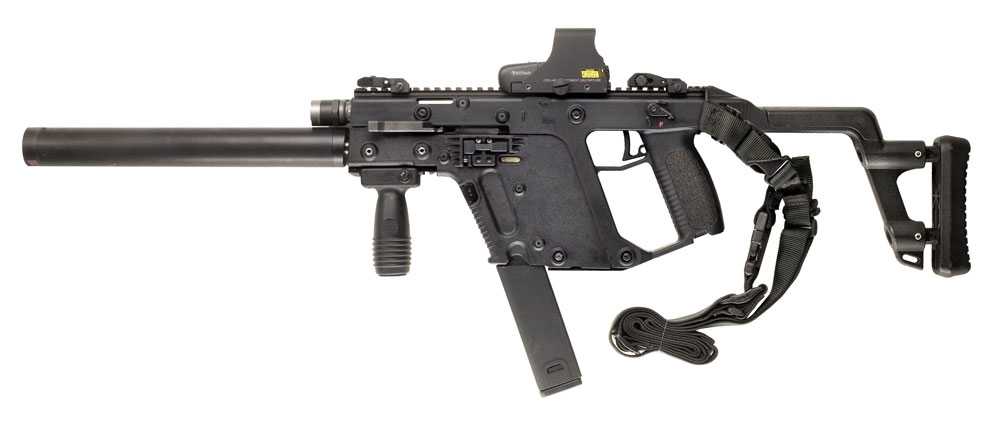
This ugly, ugly
submachine gun is the TDI Vector. Utilizing the Kriss Super V operating
system, this weapon spews .45 caliber rounds with almost no recoil or muzzle
climb. Named after the Southeast Asian dagger, the Kriss system compensates for
recoil by channeling the bolt downwards in a recess behind the magazine instead
of backward into the operator’s shoulder. This diverted recoil action
counteracts the upward climb of the barrel, reducing recoil to less than two
degrees of muzzle climb. Furthermore, the barrel of the weapon is in line with
the shooter’s shoulder as well as the shooter’s hand, also contributing to
reduced recoil. With the stock folded, it’s very easy to shoot this weapon
accurately one-handed
if necessary. At 1000
.45 caliber rounds per minute, that’s no small boast.
7) Franchi SPAS-12
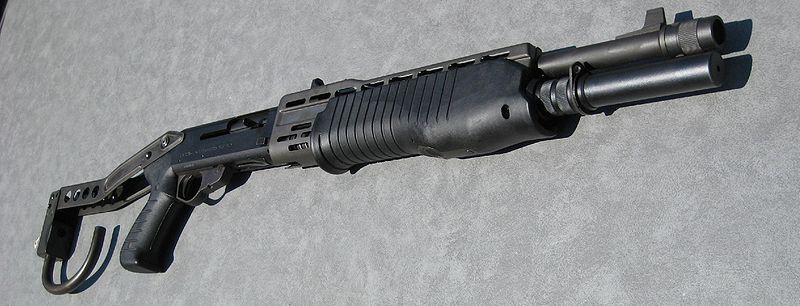
This is not a pretty sight.
The Sport Purpose Automatic Shotgun
(or, depending on who you talk to, the Special Purpose Assault Shotgun) weighs
(you guessed
it!) about 10 pounds and fires 2 ¾ inch 12-gauge shells. Because it’s
another instantly
recognizable weapon, Hollywood
loves this one. From Jurassic Park
to The Matrix
to Snatch,
chances are you’ve seen it in at least one of the last four action movies
you’ve seen. Contrary to some popular video games, though, the SPAS-12 does not feature two barrels. See that thing
below the barrel? That’s the magazine. If you had a second barrel, where would
you keep your ammunition? In yet another divergence from Valve’s otherwise
flawless FPS
masterpiece, the real SPAS-12 can go semi-auto at 4
rounds per gas-actuated second. However, to use the semi-auto feature, you need
to be firing heavy-ish loads in order to cycle the action properly. Another
cool feature is a magazine cut-off. When activated, this allows you to load a
(usually) special round into the chamber without having to run through the
entire magazine first. Finally, see that hook at the end of the stock?
Apparently, that’s to help you shoot the thing one-handed.
Manly.
6) IMI Galil

Back in the 70s, Israel hosted a
competition aimed (ha-ha)
at replacing their dust-sensitive FN FALs for a weapon better suited to an arid
environment. After beating out both the M16A1 and the AK-47, this rifle
entered IDF service in 1972. This rifle’s gas-driven piston system and fire
selector are derived from the AK-47, while its trigger mechanism is patterned
after the M1 Garand. IMI also brought in some unique
design features, as well. For example, the bipod on the ARM light machine gun
variant* forms a speed chute for rapid magazine insertion, and can double as wire cutters
to handle barbed wire obstacles. Even better, the bipod is designed to be used as a beer
bottle opener to prevent soldiers from using magazine lips to open beer
bottles – a practice which damaged the magazines.
*The ARM variant weighs
about 10
pounds. I swear I’m not doing this on purpose!
5) Walker Colt Model 1847
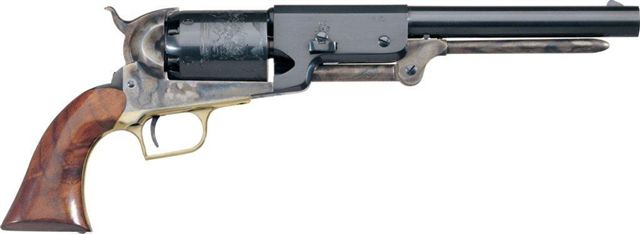
In the mid-1840s Samuels
Walker and Colt collaborated to build a handgun that was extremely powerful at
close range. What they built was a handgun that was
extremely powerful
at all ranges. An American medical
officer during the Mexican war (back when Texas was its own country) observed that
this revolver
would carry as far and strike with the same or greater force than the .54
caliber Mississippi Rifle based on his witnessing a Mexican soldier taken out
at a distance of well over 100 yards – with
a freakin’ handgun.
This weapon was the most powerful commercially-produced handgun from 1847 to
1935 when the .357 magnum cartridge was invented. That’s right – it took until
1935 to commercially produce a handgun that was more powerful than this black powder revolver.
4) PPSh-41 (Shpagin Machine Pistol)

Yet another weapon that the Soviets
produced in ludicrous numbers during WWII, the
Pah-Pah-sha was a cheaper (and improved) alternative to other Soviet SMGs like
the PPD-40. A chrome-lined chamber meant that it was very low-maintenance in
combat and stamped-metal parts meant that it could be produced at a converted
automobile repair garage or a tin shop quickly (7.3 machining hours per SMG)
and cheaply. At the end of the war, the Soviets had produced six million of these babies. The best part?
This thing could fire 900 rounds/minute
and featured a 71-round drum magazine. The Red Army equipped whole regiments
and even entire divisions with PPSh-41s. The 7.62x25mm Tokarev round it fired
was ripped off from the German 7.63x25 Mauser round, although the Russian
version hits harder – hard enough to easily defeat Class I and II ballistic
vests! The Soviets loved this weapon and so did the Nazis. In fact, they
captured and held on to so many of these that it became the second-most-common
SMG used by the German forces in WWII. They even printed German-language
manuals for this weapon and attempted to convert the things to 9x19mm
Parabellum rounds to conform better to German logistics. You know you’re using
a good weapon when your enemy ditches
his own weapon for yours.
3) M1918 Browning Automatic Rifle (BAR)

How many lists of manly
firearms would be complete without mentioning at least one of John Browning’s
creations? Despite its name, the Army actually adopted this beast in 1917 (it was
given the name M1918 so it wouldn’t be confused with Browning’s water-cooled machinegun,
already named M1917) after Browning personally showed up with it in Washington
DC and wowed 300 politicians, officers, and reporters with a live-fire
demonstration of this weapon. The government was so impressed that they
immediately adopted the weapon into service and awarded Browning the contract.
When the US
entered WWI,
we realized we only had just over 1,100 machineguns for the entire Army, most
of the MGs being surplus or second-rate models donated by the French. By
mid-1918, the BAR arrived at the front lines in France. 2nd Lieutenant
Val Allen Browning (John’s son) was among the US soldiers who brought this new
weapon to bear against the German forces. It made such an impression on the
French that they ended up buying 15,000 BARs to replace their notoriously
crappy Chauchat machine rifles. In WWII, every soldier was trained to use
the BAR in case the regular BAR operator was hurt or killed. Even the Air Force
was known to use the BAR. There is a story of the captain of a C-46 cargo plane
who came under fire by a Japanese fighter. The captain shoved his BAR out the
C-46’s forward cabin window and emptied the
magazine into the enemy aircraft, killing the pilot. The US
armed forces used the BAR until Vietnam,
and many NATO nations and recipients of US aid used the weapon into the
1990s. The BAR was even popular with US civilians (until full-auto weapons were
restricted in 1930). Clyde Barrow (of Bonny and Clyde)
used a sawed-off
BAR he “borrowed” from a National Guard armory and actually ended up being
killed by police officers using the Colt Monitor (a BAR variant).
2) Thompson/Center Contender
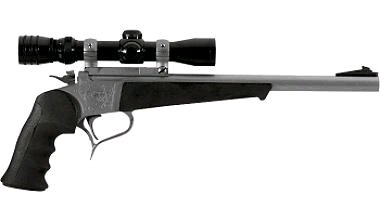
Back in 1965, Thomson Tool
Company was looking for a new product to market and Warren Center
was looking for someone to manufacture his new pistol design. Thus, the
Contender was born. The pistol is a single-shot,
break-action pistol renowned for its versatility
and unique features, as well as offering rifle-like
accuracy and power in a pistol. The Contender can switch out barrels with
the removal of the foregrip and a pin. This means that the pistol can support a
truly stupid number of calibers. Any barrel made for the Contender will fit
onto any frame, allowing you to purchase additional calibers for a fraction of
the cost of a new firearm. Since the sights are mounted on the barrel, they
stay sighted in and remain zeroed from barrel-change to barrel-change. With
two firing pins, the Contender will gladly fire both rimfire and centerfire
cartridges. As long as a cartridge’s peak pressure doesn’t exceed 48,000 CUP,
the Contender’ll shoot it. This means you can pretty much shoot anything from a
.22LR to a 30-30 Winchester
round through this pistol, including .45-70 Gov’t
and 410-bore shotgun
rounds. As you’d expect, custom barrels and calibers became very popular
with Contender owners, and wildcat cartridges became a favorite of the shooters.
Not to mention the fact that it’s a very stylish gun – characters in movies
like Hard Boiled
and Hard Target
both use this pistol in combat situations(!) with barrels chambered for .30-06
and .45-70 Gov’t exploding shells, respectively.
1) IMI
Desert Eagle Mark XIX
.50AE
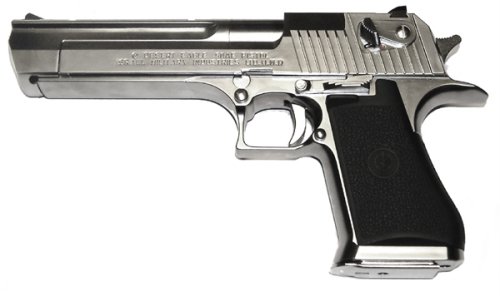
The Desert Eagle .50AE
pistol is the most
powerful automatic handgun in the world. It fires the enormous .50 caliber
Action Express cartridge which delivers about 60% more energy than a
Dirty-Harry special .44 magnum cartridge. Since the Desert Eagle is a heavy,
gas-powered automatic pistol, a significant portion of the recoil is absorbed
by the action, keeping felt recoil at strong but tolerable
levels. The .50AE Mark XIX variant is fed by a magazine containing up to seven
.50 caliber rounds, and is available in 6 or 10 inch barrel lengths. The
pistol’s polygonal rifling means less bullet deformation (which improves range,
accuracy, and velocity) and increased barrel life (due to a reduction of a
buildup of copper and lead in the barrel). The Desert Eagle’s combined size, weight, power,
and sheer recognizability
make it a favorite of supernatural characters in movies and books, villains with
something to prove to the world, and just about every present-day
first-person shooter video game ever created.
Techie disclaimer: Yeah, so
I made this webpage in MS Word. So sue me. In my defense, this list started out
life as a simple Word document, but as I kept adding hyperlinks to TVTropes, I
realized that this list would be better accessed as a webpage instead due to
issues like distribution, linking to potholes, and the fact that I deleted all
the photos of the firearms and I didn’t want to find them again just to recode
all of this stuff in HTML, so I just saved the document as a web page. :P










